HI3042 Cross-Cultural Management and Communication: Literature Review
VerifiedAdded on 2023/06/12
|12
|2667
|135
Literature Review
AI Summary
This literature review analyzes existing research on cross-cultural management and its impact on global leadership. It discusses various cross-cultural theories and their relevance to leadership styles in a globalized business environment. The review highlights the evolution of cross-cultural management practices, the challenges of cultural diversity in the workplace, and the importance of intercultural communication. It also examines the role of leadership in fostering cultural awareness and empathy among employees. Key theories, such as the theory of mass communication, behavioral analysis theory (iceberg theory), and Hofstede's cultural dimensions, are discussed in relation to their implications for cross-cultural management. The review concludes by identifying gaps in the existing literature and suggesting areas for future research, emphasizing the need for innovative approaches to address the ethical issues and short-term changes in the modern global business culture.
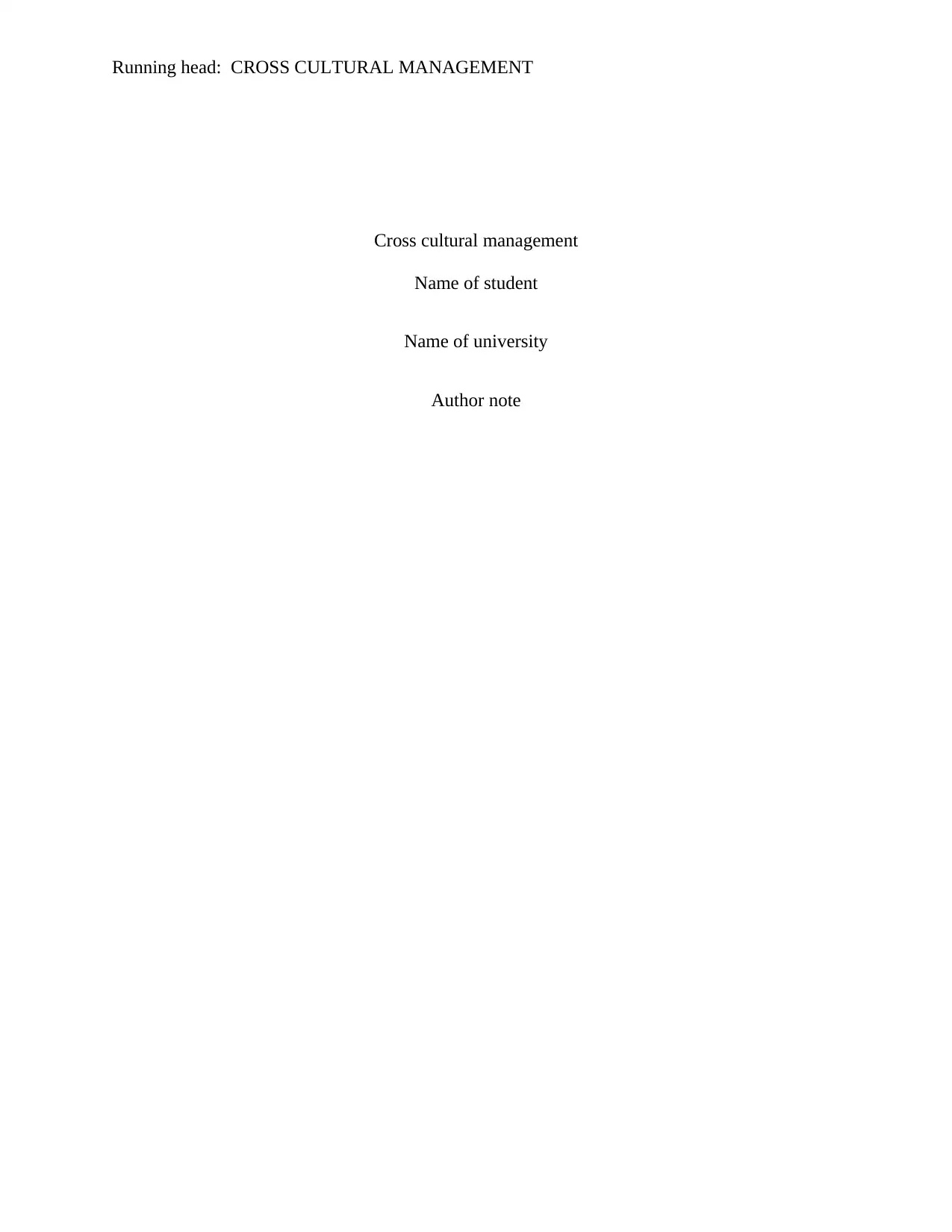
Running head: CROSS CULTURAL MANAGEMENT
Cross cultural management
Name of student
Name of university
Author note
Cross cultural management
Name of student
Name of university
Author note
Paraphrase This Document
Need a fresh take? Get an instant paraphrase of this document with our AI Paraphraser
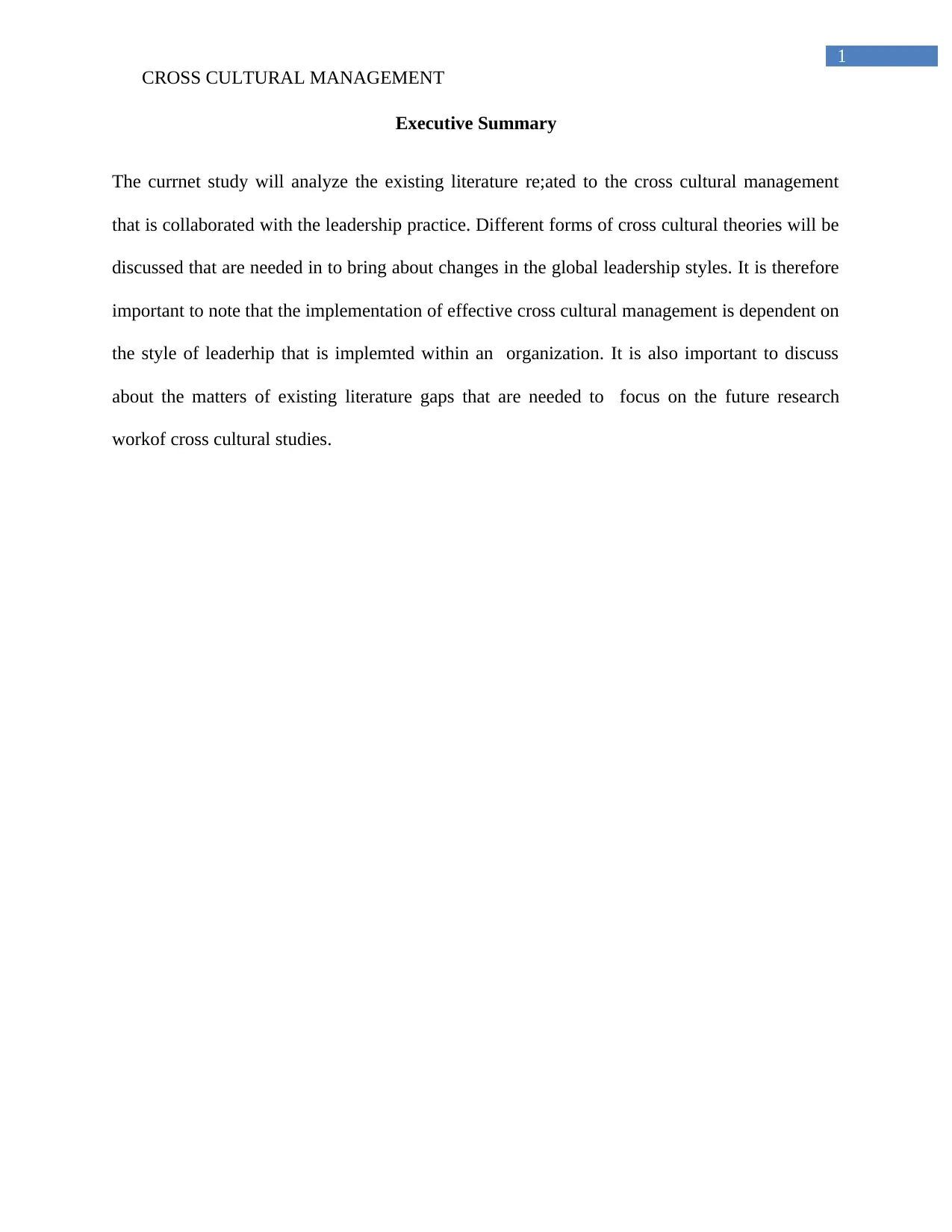
1
CROSS CULTURAL MANAGEMENT
Executive Summary
The currnet study will analyze the existing literature re;ated to the cross cultural management
that is collaborated with the leadership practice. Different forms of cross cultural theories will be
discussed that are needed in to bring about changes in the global leadership styles. It is therefore
important to note that the implementation of effective cross cultural management is dependent on
the style of leaderhip that is implemted within an organization. It is also important to discuss
about the matters of existing literature gaps that are needed to focus on the future research
workof cross cultural studies.
CROSS CULTURAL MANAGEMENT
Executive Summary
The currnet study will analyze the existing literature re;ated to the cross cultural management
that is collaborated with the leadership practice. Different forms of cross cultural theories will be
discussed that are needed in to bring about changes in the global leadership styles. It is therefore
important to note that the implementation of effective cross cultural management is dependent on
the style of leaderhip that is implemted within an organization. It is also important to discuss
about the matters of existing literature gaps that are needed to focus on the future research
workof cross cultural studies.
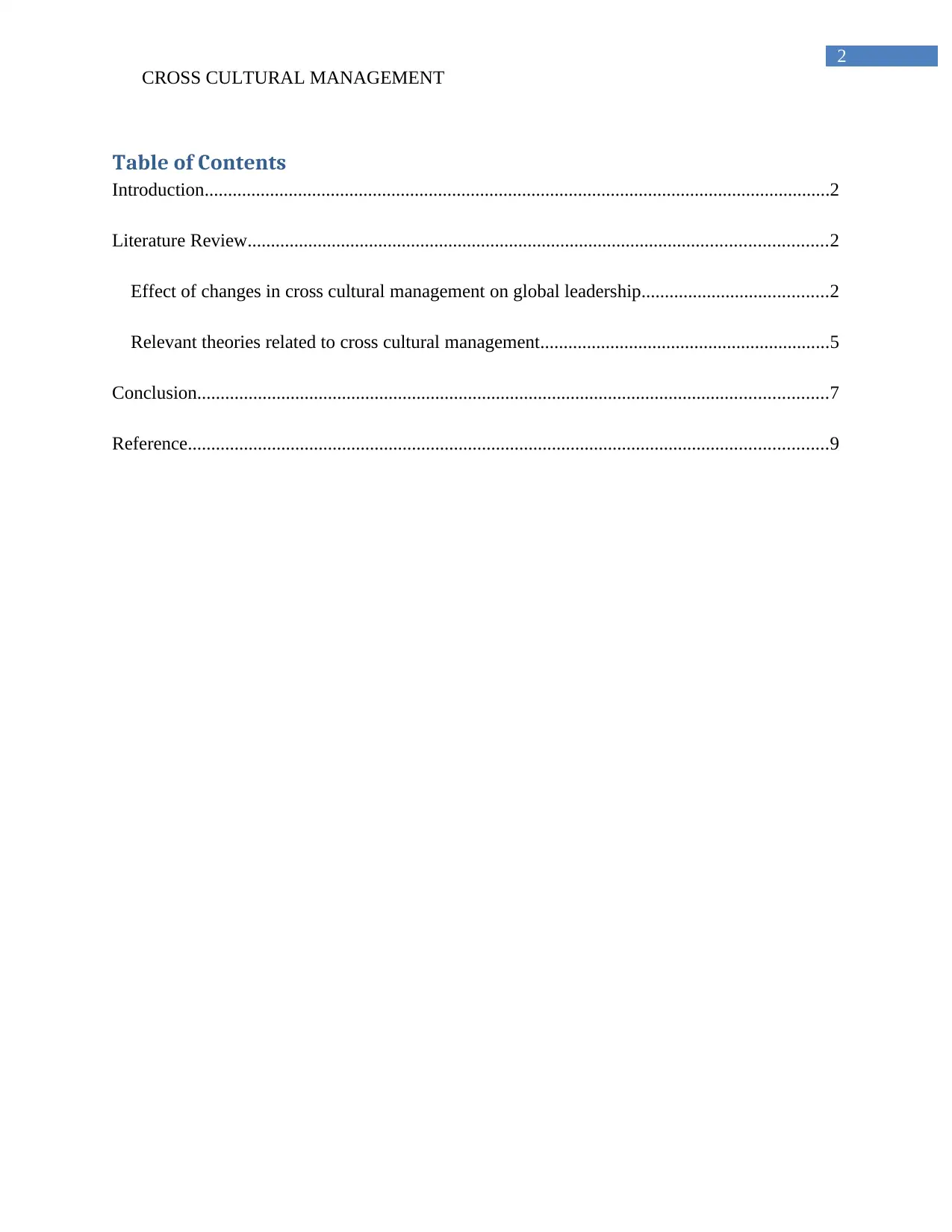
2
CROSS CULTURAL MANAGEMENT
Table of Contents
Introduction......................................................................................................................................2
Literature Review............................................................................................................................2
Effect of changes in cross cultural management on global leadership........................................2
Relevant theories related to cross cultural management..............................................................5
Conclusion.......................................................................................................................................7
Reference.........................................................................................................................................9
CROSS CULTURAL MANAGEMENT
Table of Contents
Introduction......................................................................................................................................2
Literature Review............................................................................................................................2
Effect of changes in cross cultural management on global leadership........................................2
Relevant theories related to cross cultural management..............................................................5
Conclusion.......................................................................................................................................7
Reference.........................................................................................................................................9
⊘ This is a preview!⊘
Do you want full access?
Subscribe today to unlock all pages.

Trusted by 1+ million students worldwide
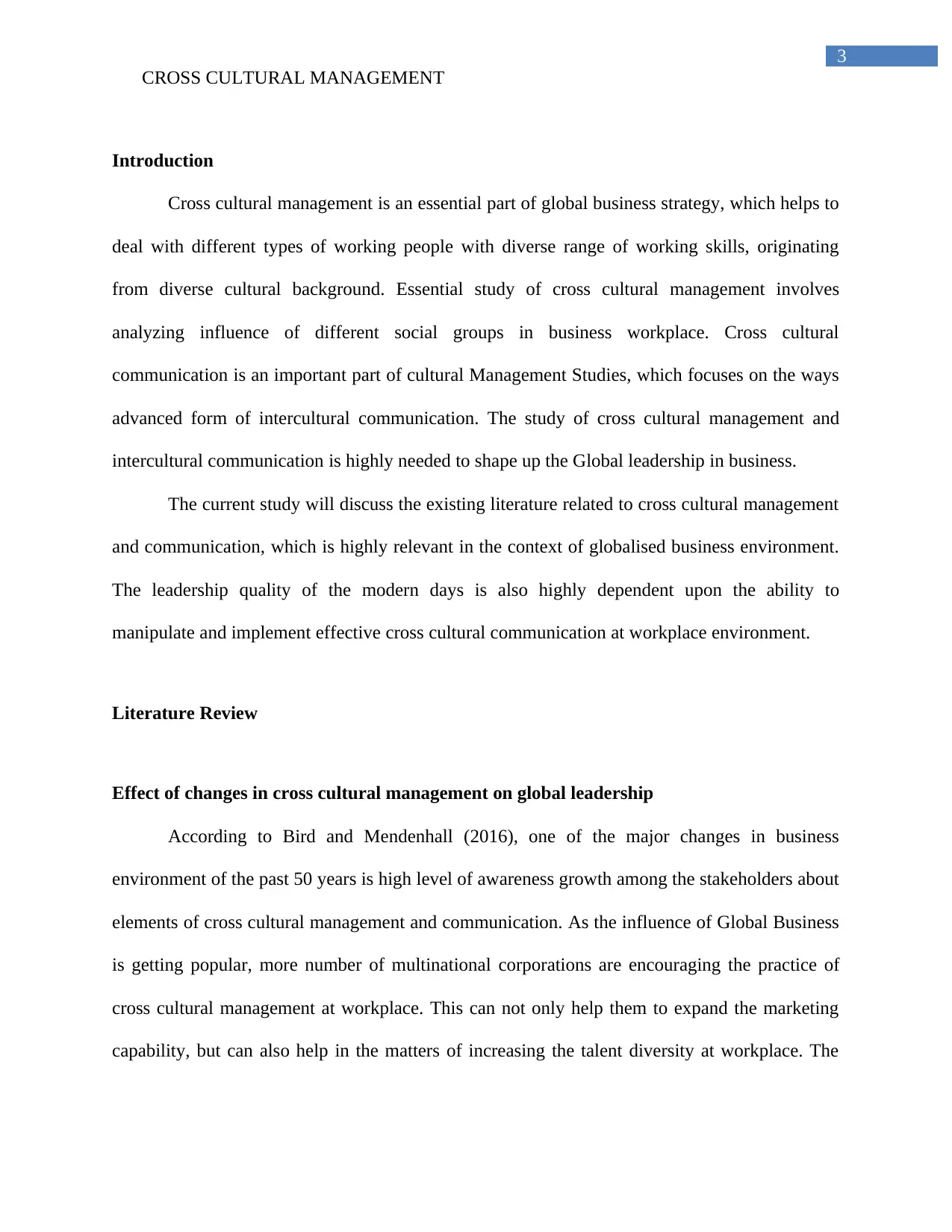
3
CROSS CULTURAL MANAGEMENT
Introduction
Cross cultural management is an essential part of global business strategy, which helps to
deal with different types of working people with diverse range of working skills, originating
from diverse cultural background. Essential study of cross cultural management involves
analyzing influence of different social groups in business workplace. Cross cultural
communication is an important part of cultural Management Studies, which focuses on the ways
advanced form of intercultural communication. The study of cross cultural management and
intercultural communication is highly needed to shape up the Global leadership in business.
The current study will discuss the existing literature related to cross cultural management
and communication, which is highly relevant in the context of globalised business environment.
The leadership quality of the modern days is also highly dependent upon the ability to
manipulate and implement effective cross cultural communication at workplace environment.
Literature Review
Effect of changes in cross cultural management on global leadership
According to Bird and Mendenhall (2016), one of the major changes in business
environment of the past 50 years is high level of awareness growth among the stakeholders about
elements of cross cultural management and communication. As the influence of Global Business
is getting popular, more number of multinational corporations are encouraging the practice of
cross cultural management at workplace. This can not only help them to expand the marketing
capability, but can also help in the matters of increasing the talent diversity at workplace. The
CROSS CULTURAL MANAGEMENT
Introduction
Cross cultural management is an essential part of global business strategy, which helps to
deal with different types of working people with diverse range of working skills, originating
from diverse cultural background. Essential study of cross cultural management involves
analyzing influence of different social groups in business workplace. Cross cultural
communication is an important part of cultural Management Studies, which focuses on the ways
advanced form of intercultural communication. The study of cross cultural management and
intercultural communication is highly needed to shape up the Global leadership in business.
The current study will discuss the existing literature related to cross cultural management
and communication, which is highly relevant in the context of globalised business environment.
The leadership quality of the modern days is also highly dependent upon the ability to
manipulate and implement effective cross cultural communication at workplace environment.
Literature Review
Effect of changes in cross cultural management on global leadership
According to Bird and Mendenhall (2016), one of the major changes in business
environment of the past 50 years is high level of awareness growth among the stakeholders about
elements of cross cultural management and communication. As the influence of Global Business
is getting popular, more number of multinational corporations are encouraging the practice of
cross cultural management at workplace. This can not only help them to expand the marketing
capability, but can also help in the matters of increasing the talent diversity at workplace. The
Paraphrase This Document
Need a fresh take? Get an instant paraphrase of this document with our AI Paraphraser
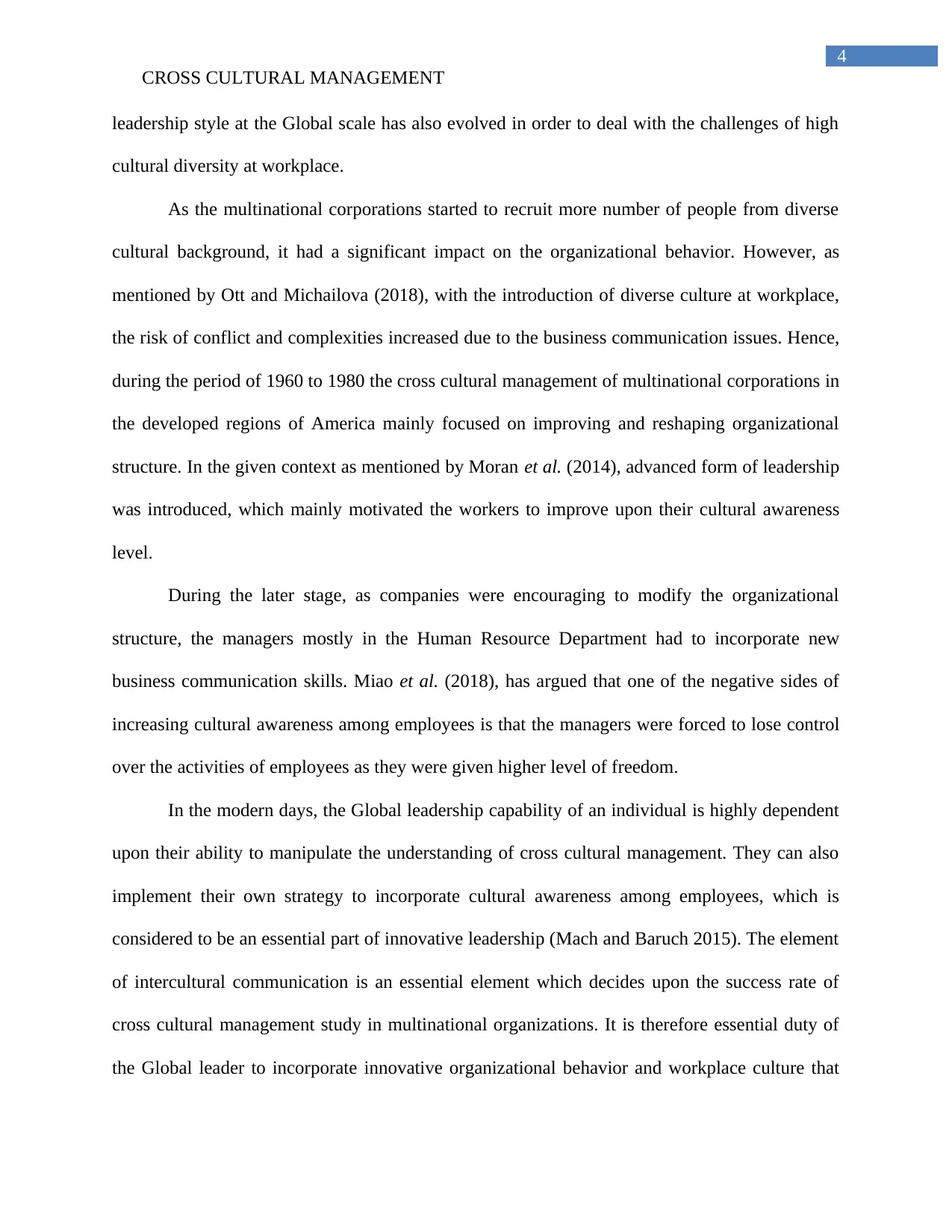
4
CROSS CULTURAL MANAGEMENT
leadership style at the Global scale has also evolved in order to deal with the challenges of high
cultural diversity at workplace.
As the multinational corporations started to recruit more number of people from diverse
cultural background, it had a significant impact on the organizational behavior. However, as
mentioned by Ott and Michailova (2018), with the introduction of diverse culture at workplace,
the risk of conflict and complexities increased due to the business communication issues. Hence,
during the period of 1960 to 1980 the cross cultural management of multinational corporations in
the developed regions of America mainly focused on improving and reshaping organizational
structure. In the given context as mentioned by Moran et al. (2014), advanced form of leadership
was introduced, which mainly motivated the workers to improve upon their cultural awareness
level.
During the later stage, as companies were encouraging to modify the organizational
structure, the managers mostly in the Human Resource Department had to incorporate new
business communication skills. Miao et al. (2018), has argued that one of the negative sides of
increasing cultural awareness among employees is that the managers were forced to lose control
over the activities of employees as they were given higher level of freedom.
In the modern days, the Global leadership capability of an individual is highly dependent
upon their ability to manipulate the understanding of cross cultural management. They can also
implement their own strategy to incorporate cultural awareness among employees, which is
considered to be an essential part of innovative leadership (Mach and Baruch 2015). The element
of intercultural communication is an essential element which decides upon the success rate of
cross cultural management study in multinational organizations. It is therefore essential duty of
the Global leader to incorporate innovative organizational behavior and workplace culture that
CROSS CULTURAL MANAGEMENT
leadership style at the Global scale has also evolved in order to deal with the challenges of high
cultural diversity at workplace.
As the multinational corporations started to recruit more number of people from diverse
cultural background, it had a significant impact on the organizational behavior. However, as
mentioned by Ott and Michailova (2018), with the introduction of diverse culture at workplace,
the risk of conflict and complexities increased due to the business communication issues. Hence,
during the period of 1960 to 1980 the cross cultural management of multinational corporations in
the developed regions of America mainly focused on improving and reshaping organizational
structure. In the given context as mentioned by Moran et al. (2014), advanced form of leadership
was introduced, which mainly motivated the workers to improve upon their cultural awareness
level.
During the later stage, as companies were encouraging to modify the organizational
structure, the managers mostly in the Human Resource Department had to incorporate new
business communication skills. Miao et al. (2018), has argued that one of the negative sides of
increasing cultural awareness among employees is that the managers were forced to lose control
over the activities of employees as they were given higher level of freedom.
In the modern days, the Global leadership capability of an individual is highly dependent
upon their ability to manipulate the understanding of cross cultural management. They can also
implement their own strategy to incorporate cultural awareness among employees, which is
considered to be an essential part of innovative leadership (Mach and Baruch 2015). The element
of intercultural communication is an essential element which decides upon the success rate of
cross cultural management study in multinational organizations. It is therefore essential duty of
the Global leader to incorporate innovative organizational behavior and workplace culture that
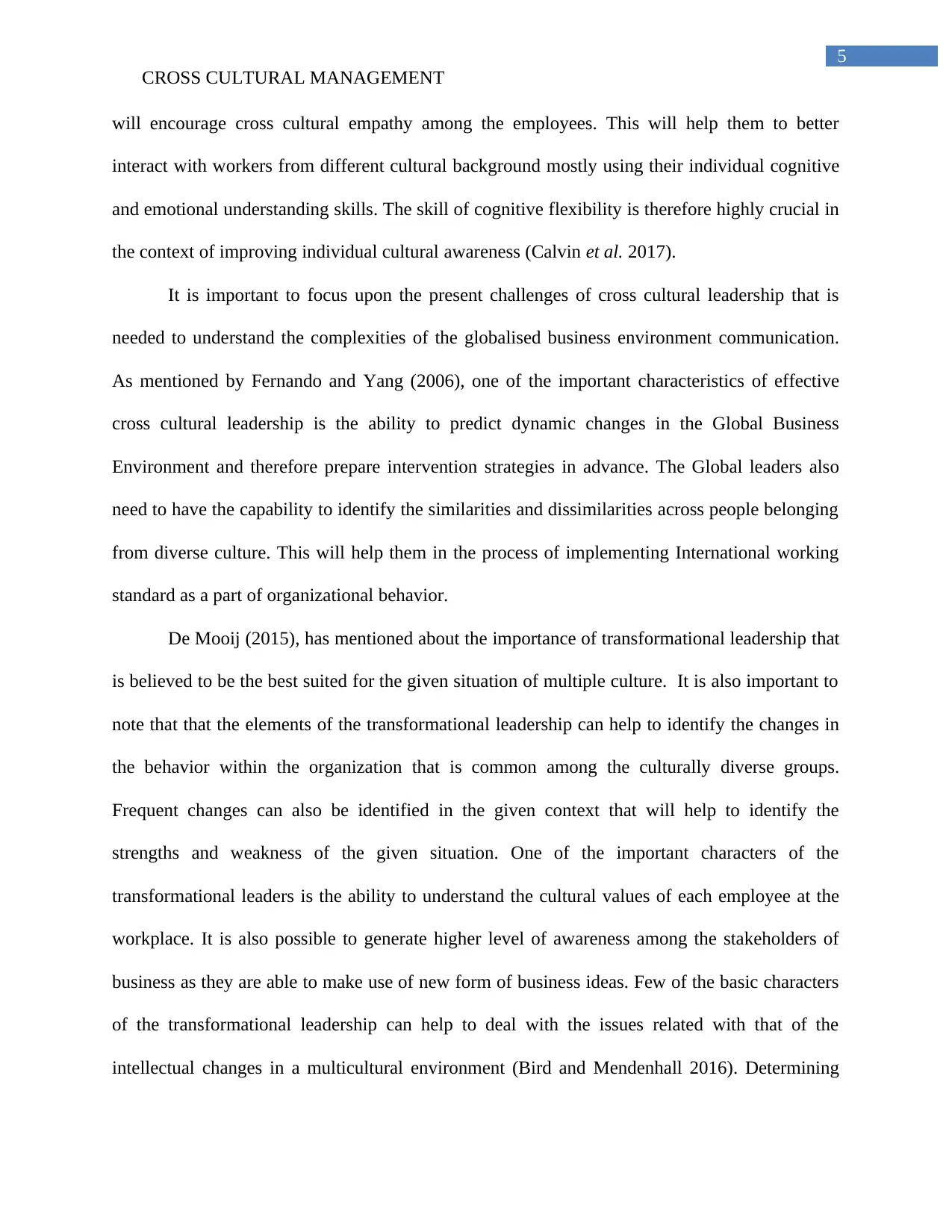
5
CROSS CULTURAL MANAGEMENT
will encourage cross cultural empathy among the employees. This will help them to better
interact with workers from different cultural background mostly using their individual cognitive
and emotional understanding skills. The skill of cognitive flexibility is therefore highly crucial in
the context of improving individual cultural awareness (Calvin et al. 2017).
It is important to focus upon the present challenges of cross cultural leadership that is
needed to understand the complexities of the globalised business environment communication.
As mentioned by Fernando and Yang (2006), one of the important characteristics of effective
cross cultural leadership is the ability to predict dynamic changes in the Global Business
Environment and therefore prepare intervention strategies in advance. The Global leaders also
need to have the capability to identify the similarities and dissimilarities across people belonging
from diverse culture. This will help them in the process of implementing International working
standard as a part of organizational behavior.
De Mooij (2015), has mentioned about the importance of transformational leadership that
is believed to be the best suited for the given situation of multiple culture. It is also important to
note that that the elements of the transformational leadership can help to identify the changes in
the behavior within the organization that is common among the culturally diverse groups.
Frequent changes can also be identified in the given context that will help to identify the
strengths and weakness of the given situation. One of the important characters of the
transformational leaders is the ability to understand the cultural values of each employee at the
workplace. It is also possible to generate higher level of awareness among the stakeholders of
business as they are able to make use of new form of business ideas. Few of the basic characters
of the transformational leadership can help to deal with the issues related with that of the
intellectual changes in a multicultural environment (Bird and Mendenhall 2016). Determining
CROSS CULTURAL MANAGEMENT
will encourage cross cultural empathy among the employees. This will help them to better
interact with workers from different cultural background mostly using their individual cognitive
and emotional understanding skills. The skill of cognitive flexibility is therefore highly crucial in
the context of improving individual cultural awareness (Calvin et al. 2017).
It is important to focus upon the present challenges of cross cultural leadership that is
needed to understand the complexities of the globalised business environment communication.
As mentioned by Fernando and Yang (2006), one of the important characteristics of effective
cross cultural leadership is the ability to predict dynamic changes in the Global Business
Environment and therefore prepare intervention strategies in advance. The Global leaders also
need to have the capability to identify the similarities and dissimilarities across people belonging
from diverse culture. This will help them in the process of implementing International working
standard as a part of organizational behavior.
De Mooij (2015), has mentioned about the importance of transformational leadership that
is believed to be the best suited for the given situation of multiple culture. It is also important to
note that that the elements of the transformational leadership can help to identify the changes in
the behavior within the organization that is common among the culturally diverse groups.
Frequent changes can also be identified in the given context that will help to identify the
strengths and weakness of the given situation. One of the important characters of the
transformational leaders is the ability to understand the cultural values of each employee at the
workplace. It is also possible to generate higher level of awareness among the stakeholders of
business as they are able to make use of new form of business ideas. Few of the basic characters
of the transformational leadership can help to deal with the issues related with that of the
intellectual changes in a multicultural environment (Bird and Mendenhall 2016). Determining
⊘ This is a preview!⊘
Do you want full access?
Subscribe today to unlock all pages.

Trusted by 1+ million students worldwide
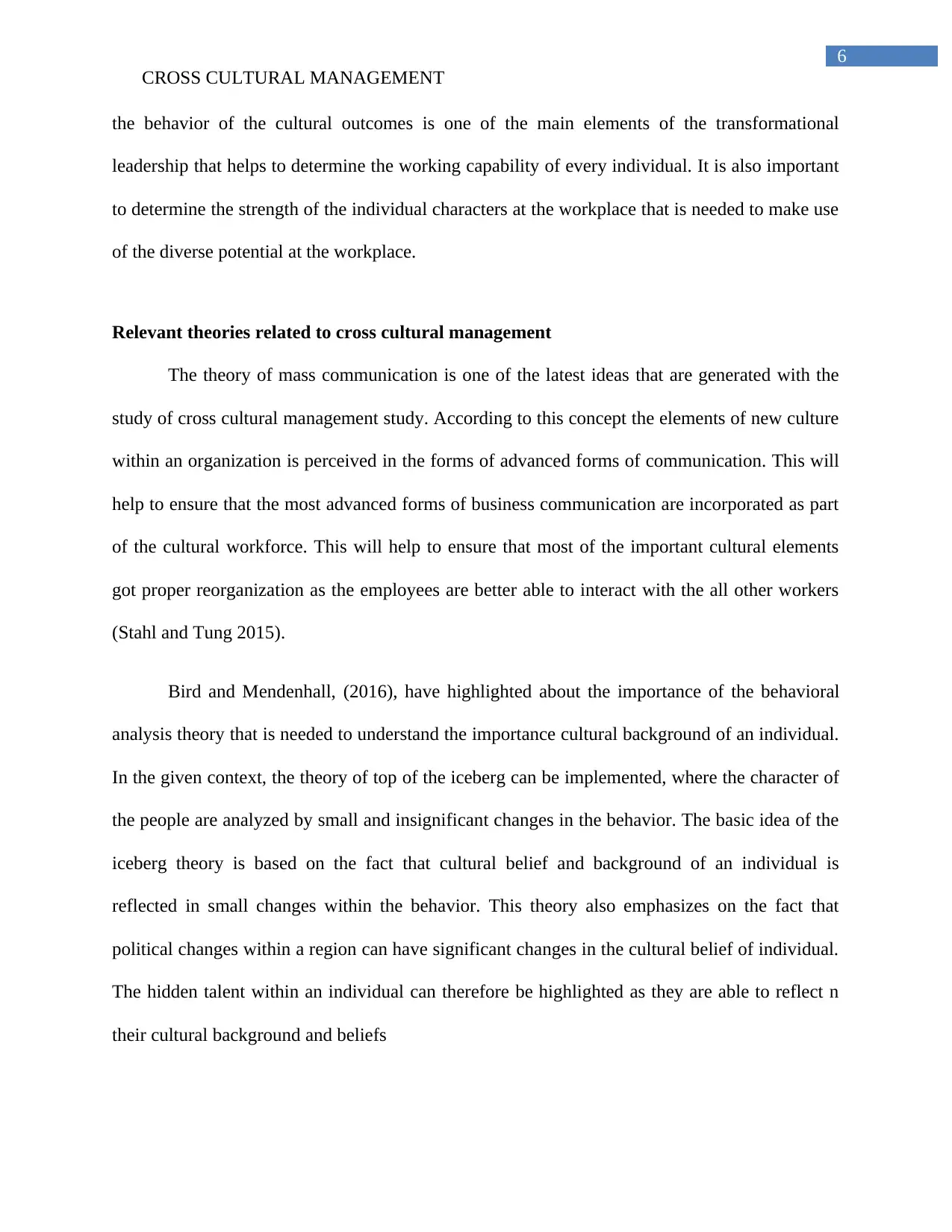
6
CROSS CULTURAL MANAGEMENT
the behavior of the cultural outcomes is one of the main elements of the transformational
leadership that helps to determine the working capability of every individual. It is also important
to determine the strength of the individual characters at the workplace that is needed to make use
of the diverse potential at the workplace.
Relevant theories related to cross cultural management
The theory of mass communication is one of the latest ideas that are generated with the
study of cross cultural management study. According to this concept the elements of new culture
within an organization is perceived in the forms of advanced forms of communication. This will
help to ensure that the most advanced forms of business communication are incorporated as part
of the cultural workforce. This will help to ensure that most of the important cultural elements
got proper reorganization as the employees are better able to interact with the all other workers
(Stahl and Tung 2015).
Bird and Mendenhall, (2016), have highlighted about the importance of the behavioral
analysis theory that is needed to understand the importance cultural background of an individual.
In the given context, the theory of top of the iceberg can be implemented, where the character of
the people are analyzed by small and insignificant changes in the behavior. The basic idea of the
iceberg theory is based on the fact that cultural belief and background of an individual is
reflected in small changes within the behavior. This theory also emphasizes on the fact that
political changes within a region can have significant changes in the cultural belief of individual.
The hidden talent within an individual can therefore be highlighted as they are able to reflect n
their cultural background and beliefs
CROSS CULTURAL MANAGEMENT
the behavior of the cultural outcomes is one of the main elements of the transformational
leadership that helps to determine the working capability of every individual. It is also important
to determine the strength of the individual characters at the workplace that is needed to make use
of the diverse potential at the workplace.
Relevant theories related to cross cultural management
The theory of mass communication is one of the latest ideas that are generated with the
study of cross cultural management study. According to this concept the elements of new culture
within an organization is perceived in the forms of advanced forms of communication. This will
help to ensure that the most advanced forms of business communication are incorporated as part
of the cultural workforce. This will help to ensure that most of the important cultural elements
got proper reorganization as the employees are better able to interact with the all other workers
(Stahl and Tung 2015).
Bird and Mendenhall, (2016), have highlighted about the importance of the behavioral
analysis theory that is needed to understand the importance cultural background of an individual.
In the given context, the theory of top of the iceberg can be implemented, where the character of
the people are analyzed by small and insignificant changes in the behavior. The basic idea of the
iceberg theory is based on the fact that cultural belief and background of an individual is
reflected in small changes within the behavior. This theory also emphasizes on the fact that
political changes within a region can have significant changes in the cultural belief of individual.
The hidden talent within an individual can therefore be highlighted as they are able to reflect n
their cultural background and beliefs
Paraphrase This Document
Need a fresh take? Get an instant paraphrase of this document with our AI Paraphraser
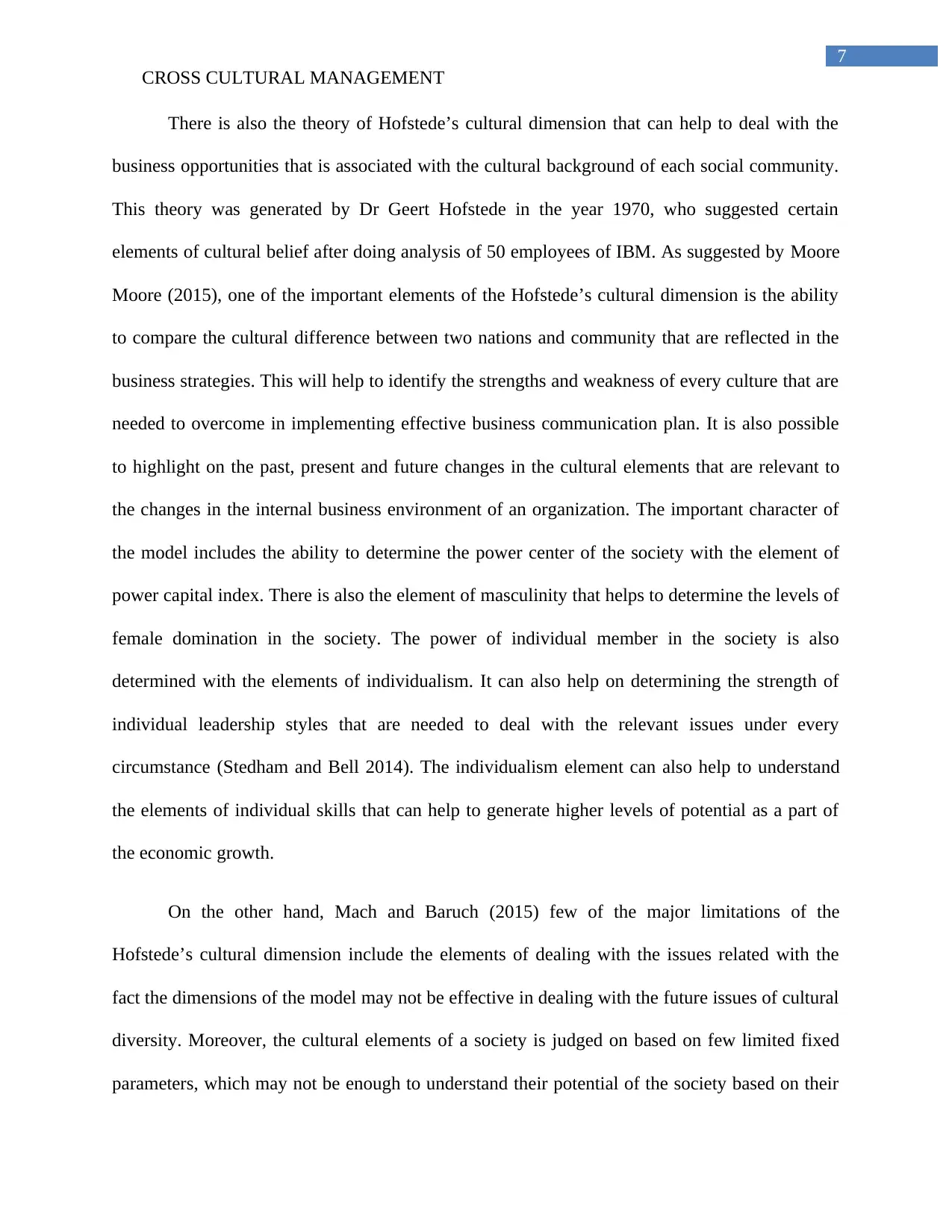
7
CROSS CULTURAL MANAGEMENT
There is also the theory of Hofstede’s cultural dimension that can help to deal with the
business opportunities that is associated with the cultural background of each social community.
This theory was generated by Dr Geert Hofstede in the year 1970, who suggested certain
elements of cultural belief after doing analysis of 50 employees of IBM. As suggested by Moore
Moore (2015), one of the important elements of the Hofstede’s cultural dimension is the ability
to compare the cultural difference between two nations and community that are reflected in the
business strategies. This will help to identify the strengths and weakness of every culture that are
needed to overcome in implementing effective business communication plan. It is also possible
to highlight on the past, present and future changes in the cultural elements that are relevant to
the changes in the internal business environment of an organization. The important character of
the model includes the ability to determine the power center of the society with the element of
power capital index. There is also the element of masculinity that helps to determine the levels of
female domination in the society. The power of individual member in the society is also
determined with the elements of individualism. It can also help on determining the strength of
individual leadership styles that are needed to deal with the relevant issues under every
circumstance (Stedham and Bell 2014). The individualism element can also help to understand
the elements of individual skills that can help to generate higher levels of potential as a part of
the economic growth.
On the other hand, Mach and Baruch (2015) few of the major limitations of the
Hofstede’s cultural dimension include the elements of dealing with the issues related with the
fact the dimensions of the model may not be effective in dealing with the future issues of cultural
diversity. Moreover, the cultural elements of a society is judged on based on few limited fixed
parameters, which may not be enough to understand their potential of the society based on their
CROSS CULTURAL MANAGEMENT
There is also the theory of Hofstede’s cultural dimension that can help to deal with the
business opportunities that is associated with the cultural background of each social community.
This theory was generated by Dr Geert Hofstede in the year 1970, who suggested certain
elements of cultural belief after doing analysis of 50 employees of IBM. As suggested by Moore
Moore (2015), one of the important elements of the Hofstede’s cultural dimension is the ability
to compare the cultural difference between two nations and community that are reflected in the
business strategies. This will help to identify the strengths and weakness of every culture that are
needed to overcome in implementing effective business communication plan. It is also possible
to highlight on the past, present and future changes in the cultural elements that are relevant to
the changes in the internal business environment of an organization. The important character of
the model includes the ability to determine the power center of the society with the element of
power capital index. There is also the element of masculinity that helps to determine the levels of
female domination in the society. The power of individual member in the society is also
determined with the elements of individualism. It can also help on determining the strength of
individual leadership styles that are needed to deal with the relevant issues under every
circumstance (Stedham and Bell 2014). The individualism element can also help to understand
the elements of individual skills that can help to generate higher levels of potential as a part of
the economic growth.
On the other hand, Mach and Baruch (2015) few of the major limitations of the
Hofstede’s cultural dimension include the elements of dealing with the issues related with the
fact the dimensions of the model may not be effective in dealing with the future issues of cultural
diversity. Moreover, the cultural elements of a society is judged on based on few limited fixed
parameters, which may not be enough to understand their potential of the society based on their
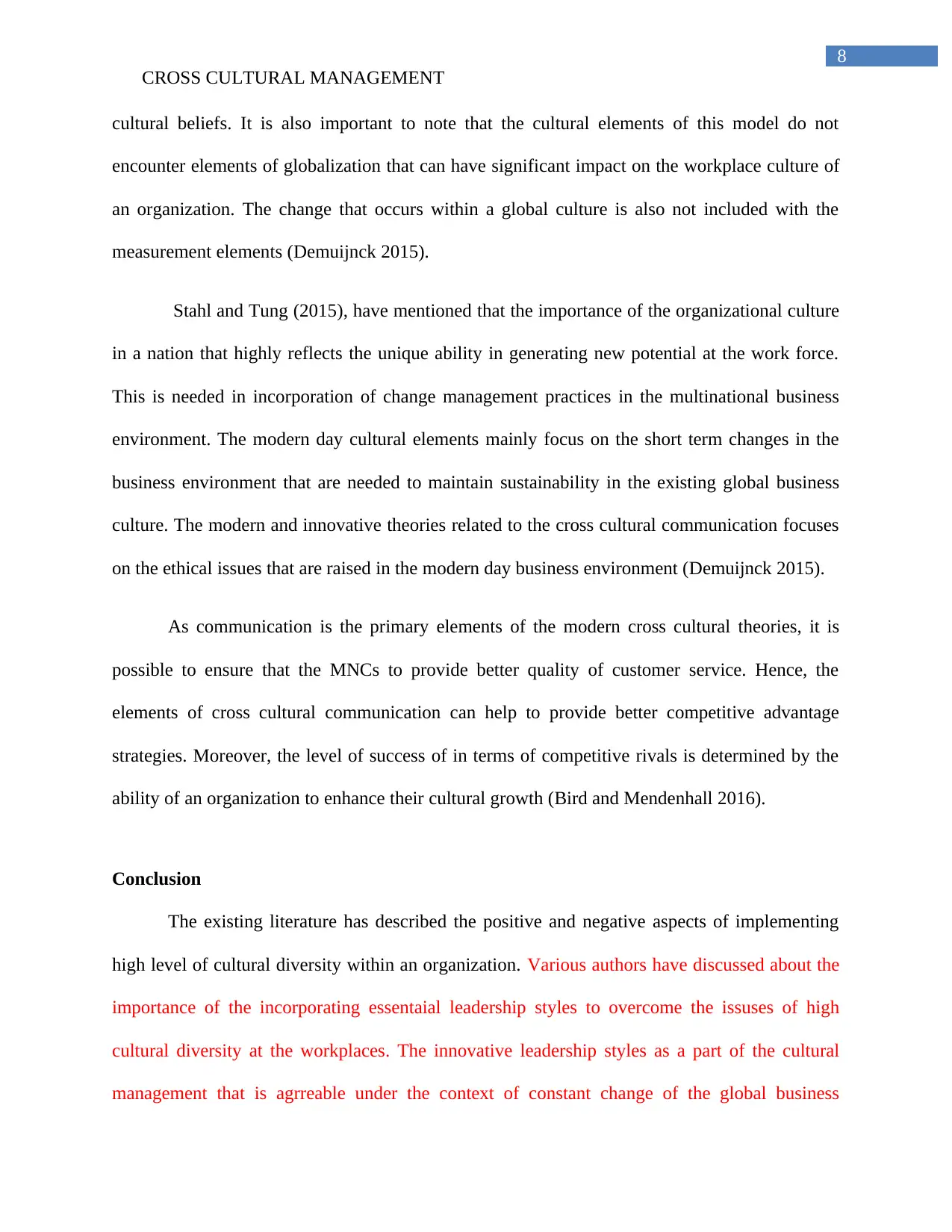
8
CROSS CULTURAL MANAGEMENT
cultural beliefs. It is also important to note that the cultural elements of this model do not
encounter elements of globalization that can have significant impact on the workplace culture of
an organization. The change that occurs within a global culture is also not included with the
measurement elements (Demuijnck 2015).
Stahl and Tung (2015), have mentioned that the importance of the organizational culture
in a nation that highly reflects the unique ability in generating new potential at the work force.
This is needed in incorporation of change management practices in the multinational business
environment. The modern day cultural elements mainly focus on the short term changes in the
business environment that are needed to maintain sustainability in the existing global business
culture. The modern and innovative theories related to the cross cultural communication focuses
on the ethical issues that are raised in the modern day business environment (Demuijnck 2015).
As communication is the primary elements of the modern cross cultural theories, it is
possible to ensure that the MNCs to provide better quality of customer service. Hence, the
elements of cross cultural communication can help to provide better competitive advantage
strategies. Moreover, the level of success of in terms of competitive rivals is determined by the
ability of an organization to enhance their cultural growth (Bird and Mendenhall 2016).
Conclusion
The existing literature has described the positive and negative aspects of implementing
high level of cultural diversity within an organization. Various authors have discussed about the
importance of the incorporating essentaial leadership styles to overcome the issuses of high
cultural diversity at the workplaces. The innovative leadership styles as a part of the cultural
management that is agrreable under the context of constant change of the global business
CROSS CULTURAL MANAGEMENT
cultural beliefs. It is also important to note that the cultural elements of this model do not
encounter elements of globalization that can have significant impact on the workplace culture of
an organization. The change that occurs within a global culture is also not included with the
measurement elements (Demuijnck 2015).
Stahl and Tung (2015), have mentioned that the importance of the organizational culture
in a nation that highly reflects the unique ability in generating new potential at the work force.
This is needed in incorporation of change management practices in the multinational business
environment. The modern day cultural elements mainly focus on the short term changes in the
business environment that are needed to maintain sustainability in the existing global business
culture. The modern and innovative theories related to the cross cultural communication focuses
on the ethical issues that are raised in the modern day business environment (Demuijnck 2015).
As communication is the primary elements of the modern cross cultural theories, it is
possible to ensure that the MNCs to provide better quality of customer service. Hence, the
elements of cross cultural communication can help to provide better competitive advantage
strategies. Moreover, the level of success of in terms of competitive rivals is determined by the
ability of an organization to enhance their cultural growth (Bird and Mendenhall 2016).
Conclusion
The existing literature has described the positive and negative aspects of implementing
high level of cultural diversity within an organization. Various authors have discussed about the
importance of the incorporating essentaial leadership styles to overcome the issuses of high
cultural diversity at the workplaces. The innovative leadership styles as a part of the cultural
management that is agrreable under the context of constant change of the global business
⊘ This is a preview!⊘
Do you want full access?
Subscribe today to unlock all pages.

Trusted by 1+ million students worldwide
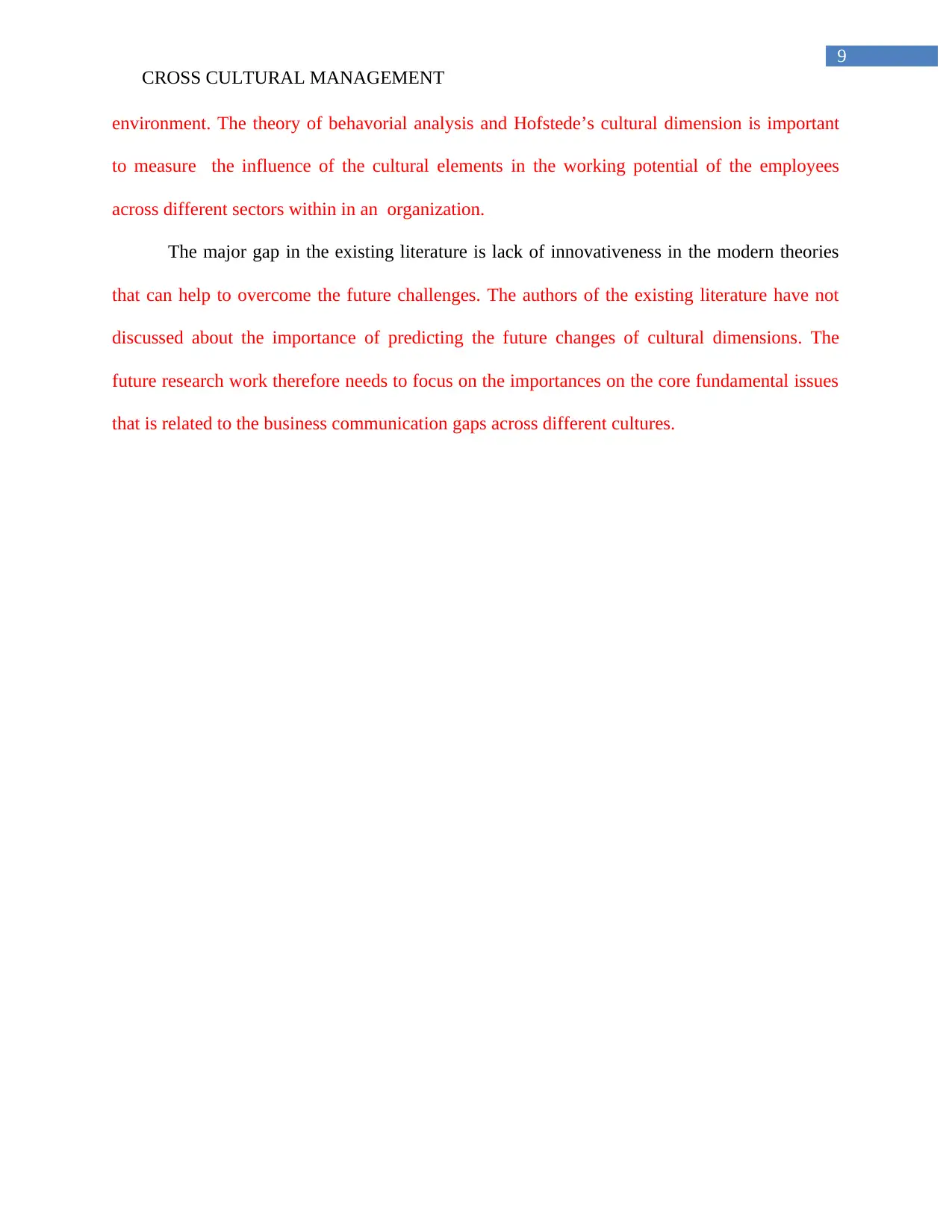
9
CROSS CULTURAL MANAGEMENT
environment. The theory of behavorial analysis and Hofstede’s cultural dimension is important
to measure the influence of the cultural elements in the working potential of the employees
across different sectors within in an organization.
The major gap in the existing literature is lack of innovativeness in the modern theories
that can help to overcome the future challenges. The authors of the existing literature have not
discussed about the importance of predicting the future changes of cultural dimensions. The
future research work therefore needs to focus on the importances on the core fundamental issues
that is related to the business communication gaps across different cultures.
CROSS CULTURAL MANAGEMENT
environment. The theory of behavorial analysis and Hofstede’s cultural dimension is important
to measure the influence of the cultural elements in the working potential of the employees
across different sectors within in an organization.
The major gap in the existing literature is lack of innovativeness in the modern theories
that can help to overcome the future challenges. The authors of the existing literature have not
discussed about the importance of predicting the future changes of cultural dimensions. The
future research work therefore needs to focus on the importances on the core fundamental issues
that is related to the business communication gaps across different cultures.
Paraphrase This Document
Need a fresh take? Get an instant paraphrase of this document with our AI Paraphraser
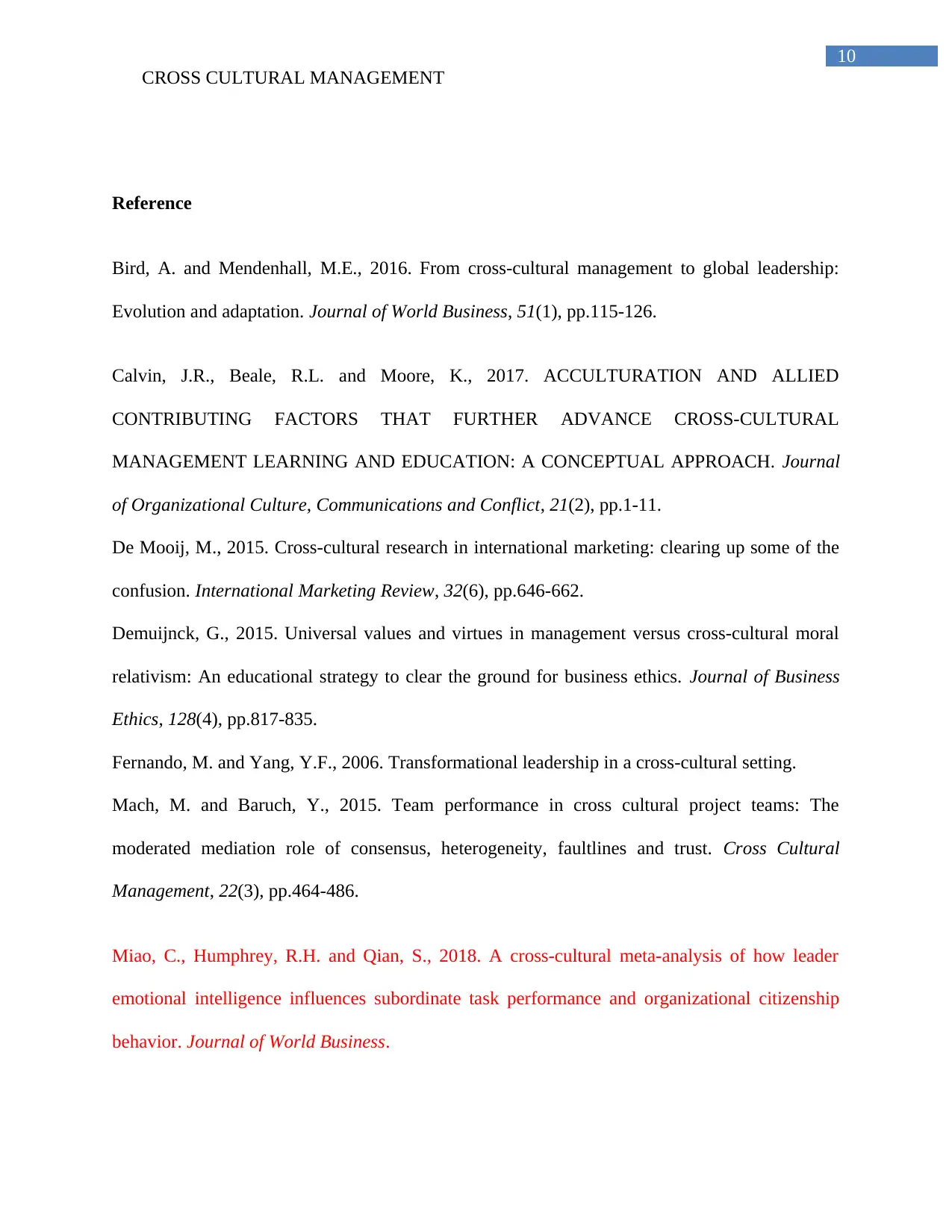
10
CROSS CULTURAL MANAGEMENT
Reference
Bird, A. and Mendenhall, M.E., 2016. From cross-cultural management to global leadership:
Evolution and adaptation. Journal of World Business, 51(1), pp.115-126.
Calvin, J.R., Beale, R.L. and Moore, K., 2017. ACCULTURATION AND ALLIED
CONTRIBUTING FACTORS THAT FURTHER ADVANCE CROSS-CULTURAL
MANAGEMENT LEARNING AND EDUCATION: A CONCEPTUAL APPROACH. Journal
of Organizational Culture, Communications and Conflict, 21(2), pp.1-11.
De Mooij, M., 2015. Cross-cultural research in international marketing: clearing up some of the
confusion. International Marketing Review, 32(6), pp.646-662.
Demuijnck, G., 2015. Universal values and virtues in management versus cross-cultural moral
relativism: An educational strategy to clear the ground for business ethics. Journal of Business
Ethics, 128(4), pp.817-835.
Fernando, M. and Yang, Y.F., 2006. Transformational leadership in a cross-cultural setting.
Mach, M. and Baruch, Y., 2015. Team performance in cross cultural project teams: The
moderated mediation role of consensus, heterogeneity, faultlines and trust. Cross Cultural
Management, 22(3), pp.464-486.
Miao, C., Humphrey, R.H. and Qian, S., 2018. A cross-cultural meta-analysis of how leader
emotional intelligence influences subordinate task performance and organizational citizenship
behavior. Journal of World Business.
CROSS CULTURAL MANAGEMENT
Reference
Bird, A. and Mendenhall, M.E., 2016. From cross-cultural management to global leadership:
Evolution and adaptation. Journal of World Business, 51(1), pp.115-126.
Calvin, J.R., Beale, R.L. and Moore, K., 2017. ACCULTURATION AND ALLIED
CONTRIBUTING FACTORS THAT FURTHER ADVANCE CROSS-CULTURAL
MANAGEMENT LEARNING AND EDUCATION: A CONCEPTUAL APPROACH. Journal
of Organizational Culture, Communications and Conflict, 21(2), pp.1-11.
De Mooij, M., 2015. Cross-cultural research in international marketing: clearing up some of the
confusion. International Marketing Review, 32(6), pp.646-662.
Demuijnck, G., 2015. Universal values and virtues in management versus cross-cultural moral
relativism: An educational strategy to clear the ground for business ethics. Journal of Business
Ethics, 128(4), pp.817-835.
Fernando, M. and Yang, Y.F., 2006. Transformational leadership in a cross-cultural setting.
Mach, M. and Baruch, Y., 2015. Team performance in cross cultural project teams: The
moderated mediation role of consensus, heterogeneity, faultlines and trust. Cross Cultural
Management, 22(3), pp.464-486.
Miao, C., Humphrey, R.H. and Qian, S., 2018. A cross-cultural meta-analysis of how leader
emotional intelligence influences subordinate task performance and organizational citizenship
behavior. Journal of World Business.
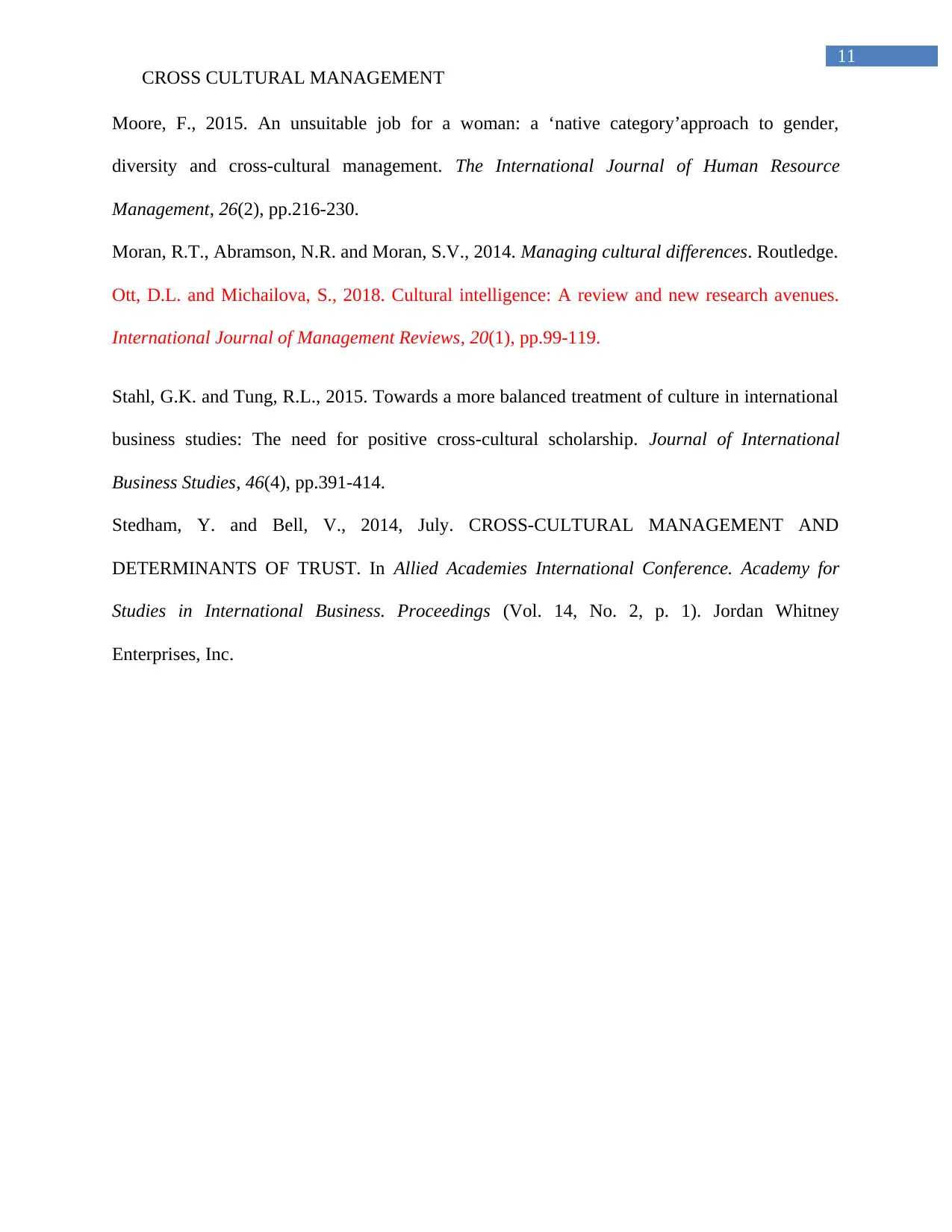
11
CROSS CULTURAL MANAGEMENT
Moore, F., 2015. An unsuitable job for a woman: a ‘native category’approach to gender,
diversity and cross-cultural management. The International Journal of Human Resource
Management, 26(2), pp.216-230.
Moran, R.T., Abramson, N.R. and Moran, S.V., 2014. Managing cultural differences. Routledge.
Ott, D.L. and Michailova, S., 2018. Cultural intelligence: A review and new research avenues.
International Journal of Management Reviews, 20(1), pp.99-119.
Stahl, G.K. and Tung, R.L., 2015. Towards a more balanced treatment of culture in international
business studies: The need for positive cross-cultural scholarship. Journal of International
Business Studies, 46(4), pp.391-414.
Stedham, Y. and Bell, V., 2014, July. CROSS-CULTURAL MANAGEMENT AND
DETERMINANTS OF TRUST. In Allied Academies International Conference. Academy for
Studies in International Business. Proceedings (Vol. 14, No. 2, p. 1). Jordan Whitney
Enterprises, Inc.
CROSS CULTURAL MANAGEMENT
Moore, F., 2015. An unsuitable job for a woman: a ‘native category’approach to gender,
diversity and cross-cultural management. The International Journal of Human Resource
Management, 26(2), pp.216-230.
Moran, R.T., Abramson, N.R. and Moran, S.V., 2014. Managing cultural differences. Routledge.
Ott, D.L. and Michailova, S., 2018. Cultural intelligence: A review and new research avenues.
International Journal of Management Reviews, 20(1), pp.99-119.
Stahl, G.K. and Tung, R.L., 2015. Towards a more balanced treatment of culture in international
business studies: The need for positive cross-cultural scholarship. Journal of International
Business Studies, 46(4), pp.391-414.
Stedham, Y. and Bell, V., 2014, July. CROSS-CULTURAL MANAGEMENT AND
DETERMINANTS OF TRUST. In Allied Academies International Conference. Academy for
Studies in International Business. Proceedings (Vol. 14, No. 2, p. 1). Jordan Whitney
Enterprises, Inc.
⊘ This is a preview!⊘
Do you want full access?
Subscribe today to unlock all pages.

Trusted by 1+ million students worldwide
1 out of 12
Related Documents
Your All-in-One AI-Powered Toolkit for Academic Success.
+13062052269
info@desklib.com
Available 24*7 on WhatsApp / Email
![[object Object]](/_next/static/media/star-bottom.7253800d.svg)
Unlock your academic potential
Copyright © 2020–2025 A2Z Services. All Rights Reserved. Developed and managed by ZUCOL.





